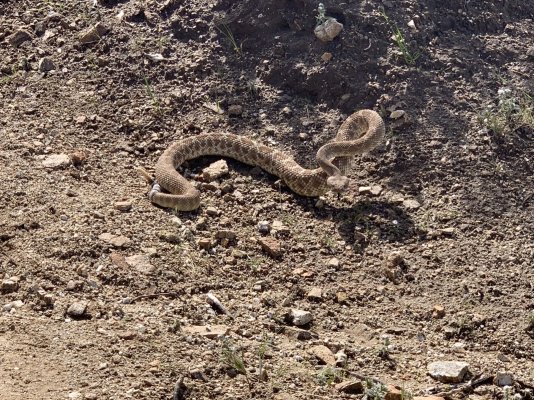I was always under the naive assumption that a snake would be more afraid of me, than me of it, and would try to slither away as soon as it detected my presence. Equally naive, I was also under the assumption we didn't have venomous snakes in Maryland.
Until, one day I was with some friends hiking on a rock formation in the Catoctin Mountains. One of my friends had gotten ahead of me, out of sight, but suddenly I heard a yell, and he came running back into view. My first thought was he had seen a bee or spider or something stupid like that, so I asked, kind of deadpan, "What is it?"
"RATTLESNAKE!" was his response. While I knew he wasn't the type to just make something up like that, I was still having trouble believing him. But, sure enough, I looked around the edge of the rock, and there it was, just laying stretched out in the middle of the path, sunning itself without a care in the world. It seemed totally unconcerned by our presence. At first I thought it might have been dead, but then noticed it was breathing.
I had been going to that park for over 20 years, and had never seen a rattlesnake. I mentioned it to a ranger at the visitor center and she said, "Oh yeah, they're all over the place, and they get used to people." I found that a bit disturbing, as I just presumed that they would feel the vibrations of a human approaching, especially on rock, and try to get away. Or at least take a defensive posture and start rattling, to try and scare off the perceived threat! I started getting this mental image of just walking along, oblivious, go around a corner, and stepping on one and getting bit.
It didn't make me afraid to go back to that park, but it definitely taught me to be more aware of my surroundings.
And, as for where I got the idea that there weren't any venomous snakes in Maryland, I think I got that mixed up from something my Dad said when I was a little kid. He probably said there weren't any venomous snakes in our particular part of Maryland, and I just remembered it wrong. But, apparently rattlesnakes are common in the western/mountainous areas. Thankfully they're not aggressive like the western Diamondback rattlesnakes, but I'd imagine they still don't make very good pets!
And apparently copperheads are almost everywhere, just less common in the coastal/flatland areas. Every once in awhile, someone will say they saw a water moccasin, but according to the Maryland Department of Natural Resources, water moccasins are not native to Maryland, and sightings of them turn out to just be generic water snakes. Still, I guess it's possible they could end up in more of the southern/swampy areas?







